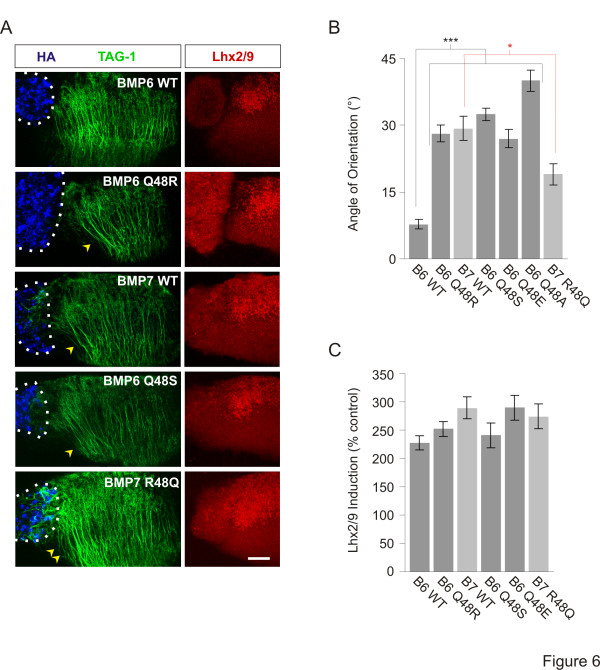Figure 6.
BMP6Gln48residue appears to inhibit orienting activity without affecting dI induction. (A) Aggregates of COS-1 cells expressing HA-tagged native (WT) and chimeric BMPs appended to [d] explants co-labeled with α-HA (blue), α-TAG-1 (green) and α-Lhx2/9 (red). Dashed lines mark appended borders of aggregates and explants. Arrowheads indicate dI axons repelled by BMP6 Q48R, BMP6 Q48S and BMP7 WT. Double arrowheads indicate reduced dI axon repulsion in explants exposed to BMP7 R48Q. Scale = 50 μm. (B) Angle of orientation in [d] explants (mean ± SEM): BMP6 WT = 7.8 ± 1.1° (n = 11); BMP6 Q48R = 28.1 ± 1.9° (n = 22); BMP7 WT = 29.3 ± 2.7° (n = 11); BMP6 Q48S = 32.5 ± 1.4° (n = 4); BMP6 Q48E = 27.0 ± 2.1° (n = 3); BMP6 Q48A = 40.0 ± 2.4° (n = 8); BMP7 R48Q = 19.0 ± 2.9° (n = 16); pMT23 = −4.8 ± 1.1° (n = 6). Student’s t tests: Axon orientation evoked by each BMP6/BMP7 chimera is significantly different from that evoked by BMP6 WT (***P <0.0001). Axon orientation evoked by BMP7 R48Q is significantly different from that evoked by BMP7 WT (*P <0.01). (C) Quantification of Lhx2/9 induction relative to control (pMT23) exposed [d] explants (mean ± SEM): BMP6 WT = 228 ± 13% (n = 11); BMP6 Q48R = 252 ± 14% (n = 16); BMP7 WT = 289 ± 19% (n = 8); BMP6 Q48S = 241 ± 22% (n = 4); BMP6 Q48E = 290 ± 22% (n = 5); BMP7 R48Q = 274 ± 21% (n = 11). Inductive activity is not statistically different between any of the native and chimeric BMPs (P = 0.1280, ANOVA).

